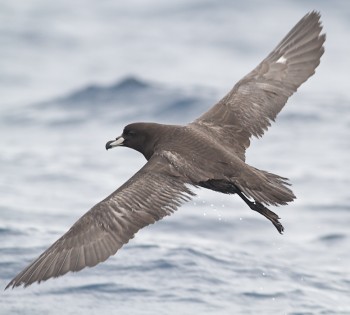The Vulnerable and ACAP-listed Westland Petrel Procellaria westlandica breeds only in South Island, New Zealand (click here). Its post-breeding migration takes it the Pacific coastal waters of southern South America (click here) but a few birds move westwards across the Tasman Sea to Australia.
A Westland Petrel rescued from the beach at Port Kembla, New South Wales, Australia on 24 December 2012 was released off Sydney Harbour by the Taronga Wildlife Hospital in late January 2013 after treatment (click here). The hospital, part of the Taronga Zoo, had previously treated a Westland Petrel in 2007. Two other birds rescued of Australian beaches in December 2012 died in captivity.
The Westland Petrel is considered to be rare in New South Wales and Queensland waters with most records from October to March. Since 1984 trips to sea off New South Wales to observe and to catch procellariiform seabirds for banding by The Southern Oceans Seabird Study Association (SOSSA) have recorded Westland Petrels on numerous occasions with sightings becoming more common in recent years. Most records have been from December, with up to five birds at a time. Two Westland Petrels have been banded by SOSSA.

Westland Petrel in flight off Wollongong, Australia, December 2012

Westland Petrel with a Flesh-footed Shearwater off Wollongong, Australia, December 2012
Photographs by Raja Stephenson
The Taranga Wildlife Hospital has also treated and released a juvenile Buller’s Albatross Thalassarche bulleri. The albatross was caught at sea for banding purposes in Australian waters but found to be underweight and to have a heavy tick load (click here).
Selected References:
Baker, G.B., Gales, R., Hamilton, S. & Wilkinson, V. 2002. Albatrosses and petrels in Australia: a review of their conservation and management. Emu 102: 71-97.
Brinkley, E.S.; Howell, S.N.G.; Force, M.P., Spear, L.B. & Ainley, D.C. 2000. Status of the Westland Petrel (Procellaria westlandica) off South America. Notornis 47: 179-183.
Fraser, P.A. 2009. Westland Petrels (Procellaria westlandica) off the coast of Chile. Notornis 56: 98-99.
Landers, T., Rayner, M.J., Phillips, R.A. & Hauber, M.E. 2011. Dynamics of seasonal movements by a trans-Pacific migrant, the Westland Petrel. The Condor 113: 71-79.
McGill, A.R. 1959. Westland Petrel: A second Australian occurrence. Emu 59: 259-264.
Robertson, C.J.R., Bell, E.A., Sinclair, N. & Bell, B.D. 2003. Distribution of seabirds from New Zealand that overlap with fisheries worldwide. Science for Conservation No. 233. Wellington: Department of Conservation. 102 pp.
Sefton, A. R. 1959. Notes on some sea-birds frequenting New South Wales coastal waters. Emu 59: 177-178.
Smith, L. 2013. Westland Petrel’s [sic] in the western Tasman Sea. The Albatross 50: 3-6.
Spear, L.B., Ainley, D.G. & Webb, S.W. 2005. Distribution, abundance, habitat use and behaviour of three Procellaria petrels off South America. Notornis 52: 88-105.
Waugh, S.M., Doherty, P.F., Freeman, A.N.D., Adams, L., Woods, G.C., Bartle, J A. & Hedley, G.K. 2006. Demography of Westland Petrels (Procellaria westlandica), 1995-2003. Emu 106: 219-226.
Wood, G.C. & Otley, H.M. 2012. An assessment of the breeding range, colony sizes and population of the Westland petrel (Procellaria westlandica). New Zealand Journal of Zoology DOI:10.1080/03014223.2012.736394.
With thanks to Janice Jenkin-Smith of the Southern Oceans Seabird Study Association.
John Cooper, ACAP Information Officer, 24 March 2013

 English
English  Français
Français  Español
Español